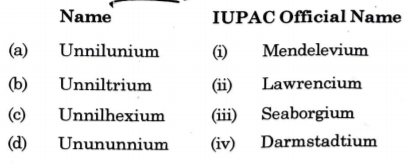Identify the incorrect statement.
The transition metals and their compounds are known for their catalytic activity due to their ability to adopt multiple oxidation states and to form complexes.
Interstitial compounds are those that are formed when small atoms like H,C, orN are trapped inside the crystal lattices of metals.
The oxidation states of chromium in are not the same.
To solve the question, "Identify the incorrect statement," we will analyze each of the four statements provided.
1. Statement 1: "Chromium (II) Cr2+ is a stronger reducing agent than Iron (II) Fe2+ in water."
- Analysis: Chromium in the +2 oxidation state has a d4 electron configuration. When it loses an electron, it becomes Cr3+ (d3), which is more stable due to the half-filled t2g orbitals. Therefore, Cr2+ acts as a strong reducing agent. Iron (II) has a d6 configuration, and it is a weaker reducing agent compared to Cr2+.
- Conclusion: This statement is correct.
2. Statement 2: "Transition metals and their compounds are known for their catalytic activity due to their ability to adopt multiple oxidation states and to form complexes."
- Analysis: Transition metals can exist in multiple oxidation states and can form various complexes, which contributes to their catalytic properties. For example, manganese can exhibit oxidation states from +2 to +7.
- Conclusion: This statement is correct.
3. Statement 3: "Interstitial compounds are those which are formed when small atoms like hydrogen, carbon, or nitrogen are trapped inside the crystal lattice of the metal."
- Analysis: Interstitial compounds are indeed formed when smaller atoms occupy the interstitial spaces in the metal's crystal lattice. This is a well-known characteristic of interstitial compounds.
- Conclusion: This statement is correct.
4. Statement 4: "The oxidation states of chromium in CrO2−4 and Cr2O2−7 are not the same."
- Analysis: To find the oxidation state of chromium in both compounds:
- For CrO2−4: Let the oxidation state of Cr be x. The equation is:
x+4(−2)=−2⟹x−8=−2⟹x=+6
- For Cr2O2−7: Let the oxidation state of Cr be x. The equation is:
2x+7(−2)=−2⟹2x−14=−2⟹2x=12⟹x=+6
- Conclusion: The oxidation states of chromium in both CrO2−4 and Cr2O2−7 are indeed the same (+6). Therefore, this statement is incorrect.
Final Answer:
The incorrect statement is Statement 4.
- Analysis: Chromium in the +2 oxidation state has a d4 electron configuration. When it loses an electron, it becomes Cr3+ (d3), which is more stable due to the half-filled t2g orbitals. Therefore, Cr2+ acts as a strong reducing agent. Iron (II) has a d6 configuration, and it is a weaker reducing agent compared to Cr2+.
- Conclusion: This statement is correct.
- Analysis: Transition metals can exist in multiple oxidation states and can form various complexes, which contributes to their catalytic properties. For example, manganese can exhibit oxidation states from +2 to +7.
- Conclusion: This statement is correct.
- Analysis: Interstitial compounds are indeed formed when smaller atoms occupy the interstitial spaces in the metal's crystal lattice. This is a well-known characteristic of interstitial compounds.
- Conclusion: This statement is correct.
- Analysis: To find the oxidation state of chromium in both compounds:
- For CrO2−4: Let the oxidation state of Cr be x. The equation is:
x+4(−2)=−2⟹x−8=−2⟹x=+6
- For Cr2O2−7: Let the oxidation state of Cr be x. The equation is:
2x+7(−2)=−2⟹2x−14=−2⟹2x=12⟹x=+6
- Conclusion: The oxidation states of chromium in both CrO2−4 and Cr2O2−7 are indeed the same (+6). Therefore, this statement is incorrect.
The incorrect statement is Statement 4.
Similar Questions
Study the following and identify the incorrect statements
(i) Muscles of iris and ciliary body are smooth muscles of mesodermal origin
(ii) Slow and sustained involuntary contraction of smooth muscles are called spasms
(iii) Quiescent mononucleate myogenic cells of skeletal muscles are called pericytes
(iv) Skeletal muscles fibre is multinucleate and is a syncytium
View SolutionIdentify the incorrect pair
View SolutionIdentify the incorrect pair
View SolutionIdentify the incorrect match
View SolutionIdentify in incorrect statements (s) w.r.t Gregor Mendel.
View SolutionIdentify the incorrect one
View SolutionIdentify incorrect statement
View SolutionA hollow sphere has charge density .σ.Cm−2. Identify incorrect statement
View SolutionIdentify the incorrect match.

View SolutionIdentify the incorrect pair.
View Solution